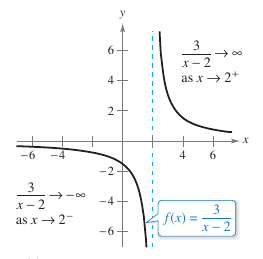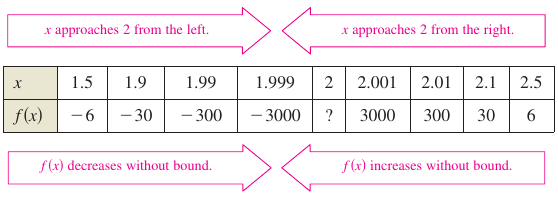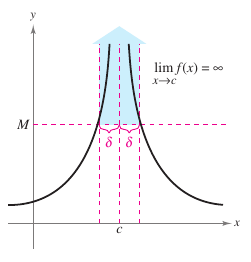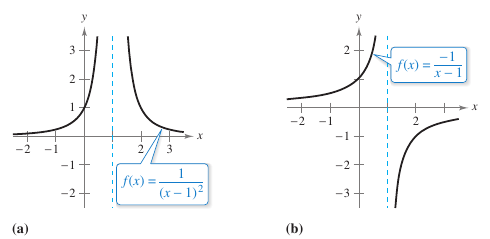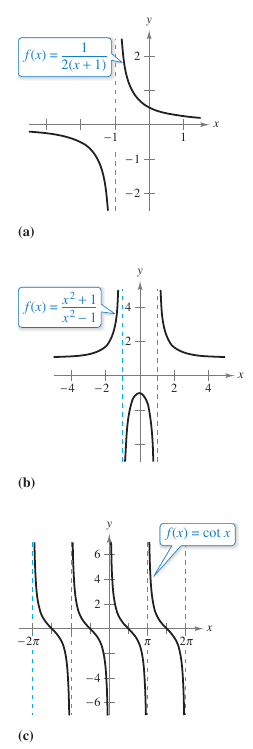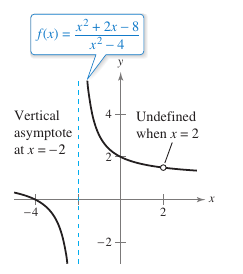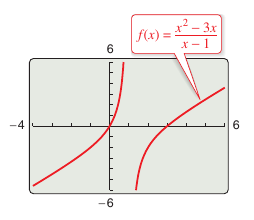Calculus I 01.05 Infinite Limits
| Previous | Calculus I 01.04 Continuity and One-Sided Limits |
| Next | Calculus I 02 Differentiation |
Contents
- 1 Infinite Limits
- 1.1 Definition 1.5.1 Infinite Limits
- 1.2 Example 1.5.1 Determining Infinite Limits from a Graph
- 1.3 Vertical Asymptotes
- 1.3.1 Definition 1.5.2 Vertical Asymptotes
- 1.3.2 Theorem 1.5.1 Vertical Asymptotes
- 1.3.3 Example 1.5.2 Finding Vertical Asymptotes
- 1.3.4 Example 1.5.3 A Rational Function with Common Factors
- 1.3.5 Example 1.5.4 Determining Infinite Limits
- 1.3.6 Theorem 1.5.2 Infinite Limits Properties
- 1.3.7 Example 1.5.5 Determining Limits
- 2 Internal Links
Infinite Limits
- Determine infinite limits from the left and from the right.
- Find and sketch the vertical asymptotes for a function graph.
Definition 1.5.1 Infinite Limits
|
|
Let \(f\) be a function that is defined at every real number on some open interval containing \(c\) (except possibly at \(c\) itself.) The statement $$ \lim_{x \to c} f(x) = \infty $$ means that for each \(M >0\) there exists a \(\delta > 0\) such that \(f(x)>M\) whenever \(0< |x-c|< \delta\), as shown in Figure 1.5.2. Similarly, the statement $$ \lim_{x \to c} f(x) = -\infty $$ means that for each \(N<0\) there exists a \(\delta >0\) such that \(f(x)<N\) whenever \(0<|x-c| < \delta.\) To define the infinite limit from the left, replace \(0<|x-c| < \delta\) by \(c-\delta<x<c\). To define the infinite limit from the right, replace \(0<|x-c| < \delta\) by \(c<x<c+\delta\). The equal sign in the statement \(\lim f(x)=\infty\) does not mean that the limit exists. It states the limit fails to exist by denoting the \(f(x)\)'s unbounded behavior \(x\) approaches \(c\). |
Example 1.5.1 Determining Infinite Limits from a Graph
Determine the limit for each function shown in Figure 1.5.3 as \(x\) approaches 1 from the left and from the right.
Solution
| a. | When \(x\) approaches 1 from the left or right, \((x-1)^2\) is a small positive number. Therefore,the quotient \(1/(x-1)^2\) is a large positive number, and \(f(x)\) approaches infinity from each side of \(x=1\). To conclude that
| ||
| Figure 1.5.3(a) confirms this analysis. | |||
| b. | When \(x\) approaches 1 from the left, \(x-1\) is a small negative number. Therefore, the quotient \(-1/(x-1)\) is a large negative number, and \(f(x)\) approaches negative infinity from the right of \(x=1\). To conclude that
| ||
When \(x\) approaches 1 from the right, \(x-1\) is a small positive number. Therefore, the quotient \(-1/(x-1)\) is a large negative number, and \(f(x)\) approaches negative infinity from the right of \(x=1\). To conclude that
| |||
| Figure 1.5.3(b) confirms this analysis. |
Vertical Asymptotes
|
|
If it were possible to extend the graphs in Figure 1.5.2 toward positive and negative infinity each graph becomes arbitrarily close to the vertical line \(x=1\). This line is a vertical asymptote for \(f\). Other asymptotes are described in Sections 3.5 and 3.6. Definition 1.5.2 Vertical AsymptotesIf \(f(x)\) approaches positive or negative infinity as \(x\) approaches \(c\) from the right or left, then the line \(x=c\) is a vertical asymptote for \(f\). If \(f\) has a vertical asymptote at \(x=c\), then \(f\) is not continuous at \(c\). In Example 1.5.1 note that each functions is a quotient and that each vertical asymptote occurs at a number at which the denominator is 0 (and the numerator is not 0). Theorem 1.5.1 generalizes this observation. Theorem 1.5.1 Vertical AsymptotesLet \(f\) and \(g\) be continuous on an open interval containing \(c\). If \(f(c)\neq 0\), \(g(c)=0\), and there exists an open interval containing \(c\) such that \(g(c) \neq 0\) for all \(x \neq c\) on the interval, then the graph for
has a vertical asymptote at \(x=c\). Example 1.5.2 Finding Vertical Asymptotes
|
Theorem 1.5.1 requires the numerator value for \(x=c\) be nonzero. When both the numerator and denominator are 0 at \(x=c\) an indeterminate form \(0/0\) is produced. The limit's behavior at \(x=c\) can not be determined without further investigation, as described in Example 1.5.3.
Example 1.5.3 A Rational Function with Common Factors
|
|
For \(f(x)\)'s graph determine all vertical asymptotes.
Solution Begin by simplifying the expression
Let \(g(x)\) represent the simplified expression. The graphs for \(f(x)\) and \(g(x)\) coincide at all \(x\)-values other than \(x=2\). Applying Theroem 1.5.1 to \(f\) and \(g\) produces a vertical asymptote at \(x=-2\), as shown in Figure 1.5.5. From the graphs the limit is
Note that \(x=2\) is not a vertical asymptote. |
Example 1.5.4 Determining Infinite Limits
|
|
Find each limit.
Solution Because the denominator is 0 when \(x=1\) and the numerator is not zero, the graph for
has a vertical asymptote at \(x=1\). This means that each limit is either \(\infty\) or \(-\infty\). Figure 1.5.6 shows the graph for \(f\) has an asymptote at \(x=1\) and approaches \(\infty\) from the left and approaches \(-\infty\) from the right. The answer is
|
Theorem 1.5.2 Infinite Limits Properties
Let \(c\) and \(L\) be real numbers. Let \(f\) and \(g\) be functions such that
- $$ \lim_{x \to c} f(x) = \infty \text{ and } \lim_{x \to c} g(x) =L.$$
| 1. Sum or difference: |
|
| 2. Product: |
|
| |
| 3. Quotient: |
|
Similar properties hold for one-sided limits and for functions where the limit for \(f(x)\) as \(x\) approaches \(c\) is \(-\infty\) as shown in Example 1.5.5(d).
Proof This is a proof for the Sum property. Proofs for the other properties are similar. To show that the limit for \(f(x)+g(x)\) is infinite, choose \(M>0\). Then find \(\delta >0\) such that \([f(x)+g(x)]>M\) whenever \(0<|x-c|<\delta\). Simplify by assuming \(L\) is positive. Let \(M_1=M+1\). Because the limit for \(f(x)\) is infinite, there exists \(\delta_1\) such that \(f(x)>M_1\) whenever \(0<|x-c|<\delta_1\). Because \(L\) is the limit for \(g(x)\) there exists \(\delta_2\) such that \(|g(x)-L|<1\) whenever \(0<|x-c|<\delta_2\). By letting \(\delta\) be smaller than \(\delta_1\) and \(\delta_2\), the conclusion is that \(0<|x-c|<\delta\) implies \(f(x)>M+1\) and \(|g(x)-L|<1\). The second inequality implies that \(g(x)>L-1\). Adding the inequalities produces
- \(f(x)+g(x)>(M+1)+(L-1)=M+L>M\).
- \(f(x)+g(x)>(M+1)+(L-1)=M+L>M\).
Thus,
- $$ \lim_{x \to c} [f(x) \pm g(x)] = \infty$$
Example 1.5.5 Determining Limits
| a. | Because \(\lim_{x \to 0} 1=1\) and \(\lim_{x \to 0} \frac{1}{x^2}, the expression can be written as | ||
| |||
| b. | Because \(\lim_{x \to 1^-} (x^2+1)=2\) and \(\lim_{x \to 1^-} (\cot \pi x) = -\infty\), the expression can be written as | ||
| |||
| c. | Because \(\lim_{x \to 0^+} 3=3\) and \(\lim_{x \to 0^+} \cot x = \infty\), the expression can be written as | ||
| |||
| d. | Because \(\lim_{x \to 0^-} x^2=0\) and \(\lim_{x \to 0^-} \frac{1}{x} = -\infty\), the expression can be written as | ||
|
Internal Links
Parent Article: Calculus I 01 Limits and Their Properties
